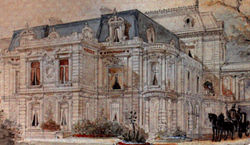Palais Rothschild, 14-16, Theresianumgasse, Vienna, Austria
The Palais Nathaniel Rothschild was a palatial house in Vienna, one of five Palais Rothschild in the city owned by members of the Rothschild banking family of Austria.
It was commissioned by Nathaniel von Rothschild (1836–1905), the brother of Albert Salomon von Rothschild. French architect Jean Girette designed and built the French Neo-baroque style palace between 1871 and 1878, situated at Theresianumgasse 16-18, in the IV (Wieden) district of Vienna.
The Palais was two storeys high, surrounded by a lush garden decorated with fountains and sculptures, the whole built to showcase the wealth of the Rothschild family. Baron Nathaniel organized a huge ball for the housewarming, including an orchestra playing antique instruments from the Baron's own priceless collection of musical instruments. The art collection housed here was renowned.[1] Baron Nathaniel was also famous for his substantial philanthropic and charitable activities.
After the annexation of Austria by Nazi Germany in 1938, the family were forced to flee and the estates seized by the Nazis. The Gestapo moved into the Palais and used the building for their interrogations. The building itself was heavily damaged during Allied bombing raids in 1944.
At the end of World War II the owners returned to find a smoldering ruin. The ruins were torn down; some of the materials were used for reconstruction around the city, apparently including the Stephansdom. The estate was eventually sold to the Austrian Chamber of Labour by the sole heiress, Baroness Clarice de Rothschild, in 1950. The Labour Chamber had the rest of the ruins torn down and erected a simple modern building for its traineesIn 1872, Nathaniel von Rothschild (1836-1905) commissioned the French architect, Jean Girette, to build him a mansion in Vienna in which to house his collection of objets d’art.
The architecture was vaguely Renaissance in style, but incorporated numerous details of contemporary ornamentation. Inside there were fifteen salons recalling the different styles of the 17th and 18th centuries.
Old decorative styles and modern features were combined to set off the objects in the collection to best advantage. The Renaissance salon, for example, was completely new, whereas elements from the Château de Bercy had been installed in a room where the main feature was a corner cupboard from the Branichi Palace in Warsaw, and the dining room housed the panelling painted in 1798 in Paris by Prudhon.
In the grounds Nathaniel built a monumental fountain at a point where it could be seen from all over the garden as well as from the house. Alphonse, Nathaniel’s nephew, later lived in the property, moving out in the early 1930s. After being severely damaged in the Second World War, the house was pulled down in 1952.
Return to Estates listing